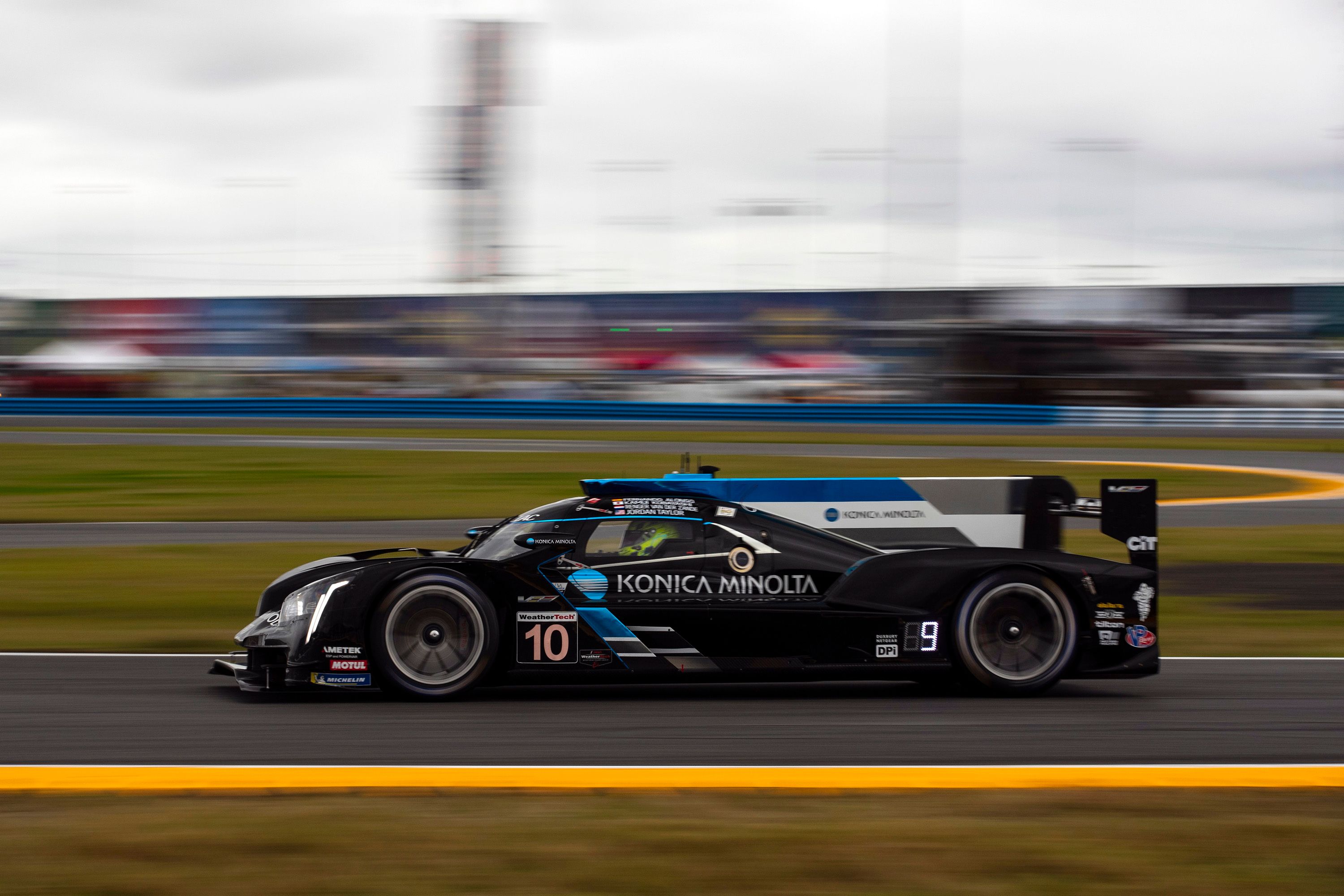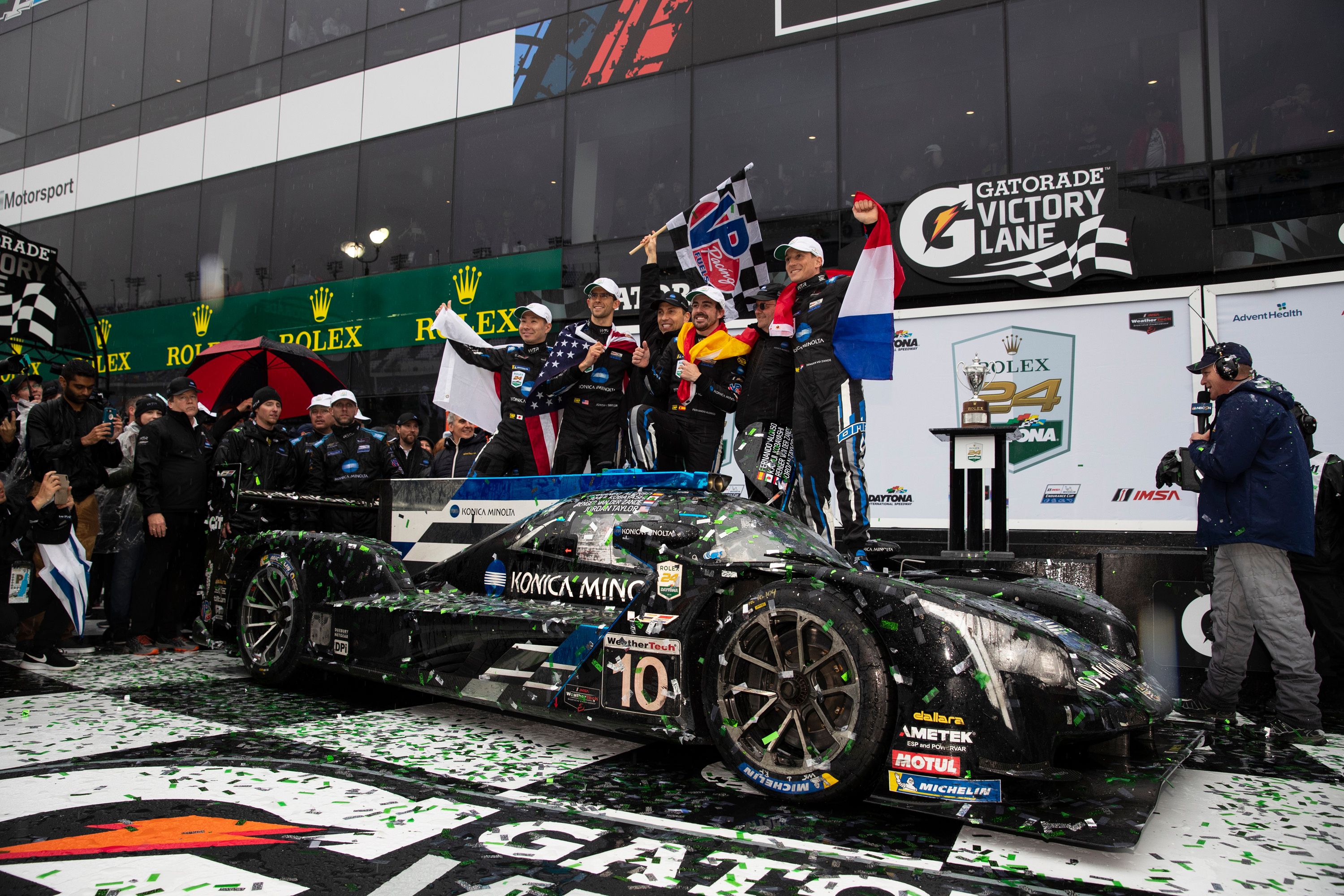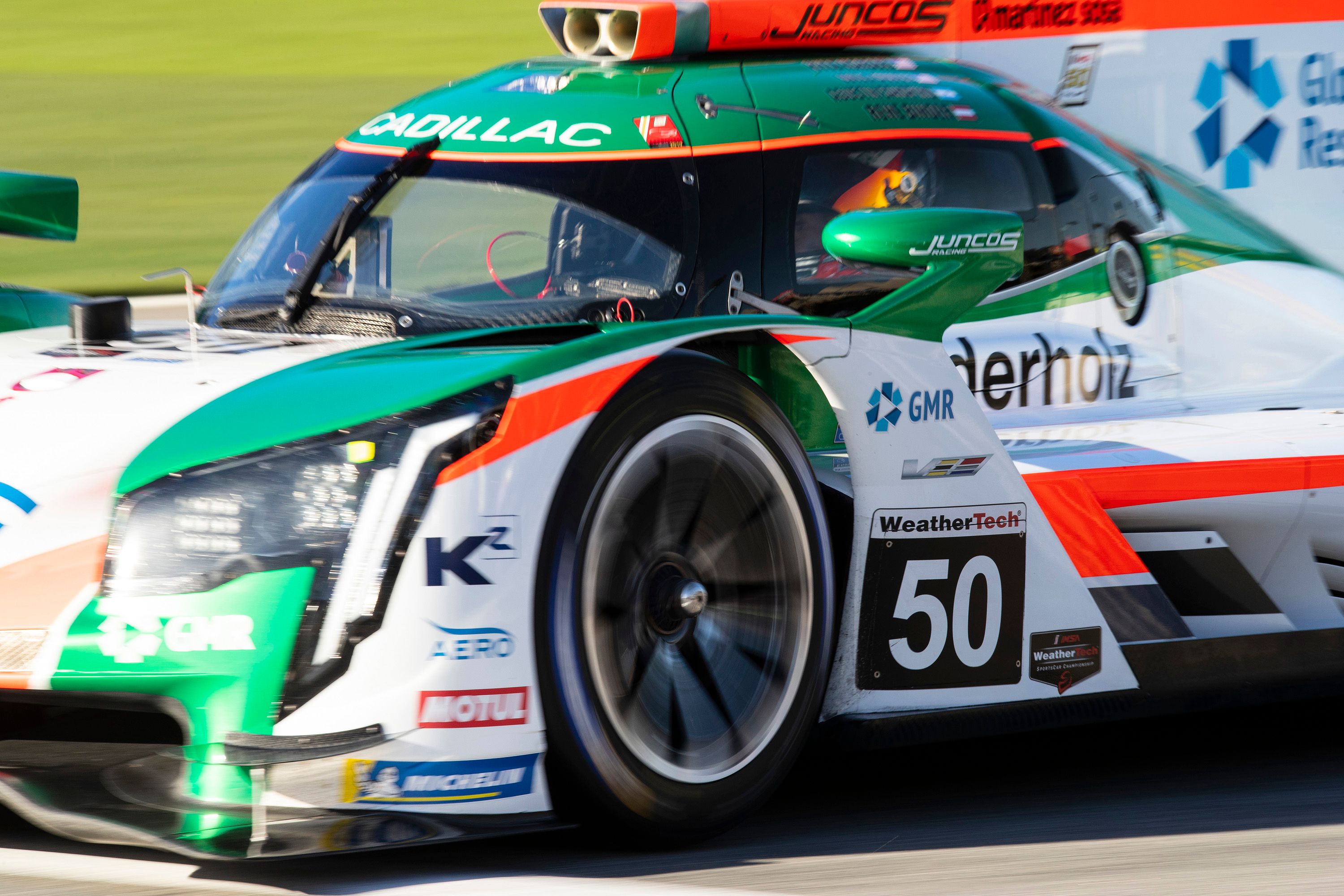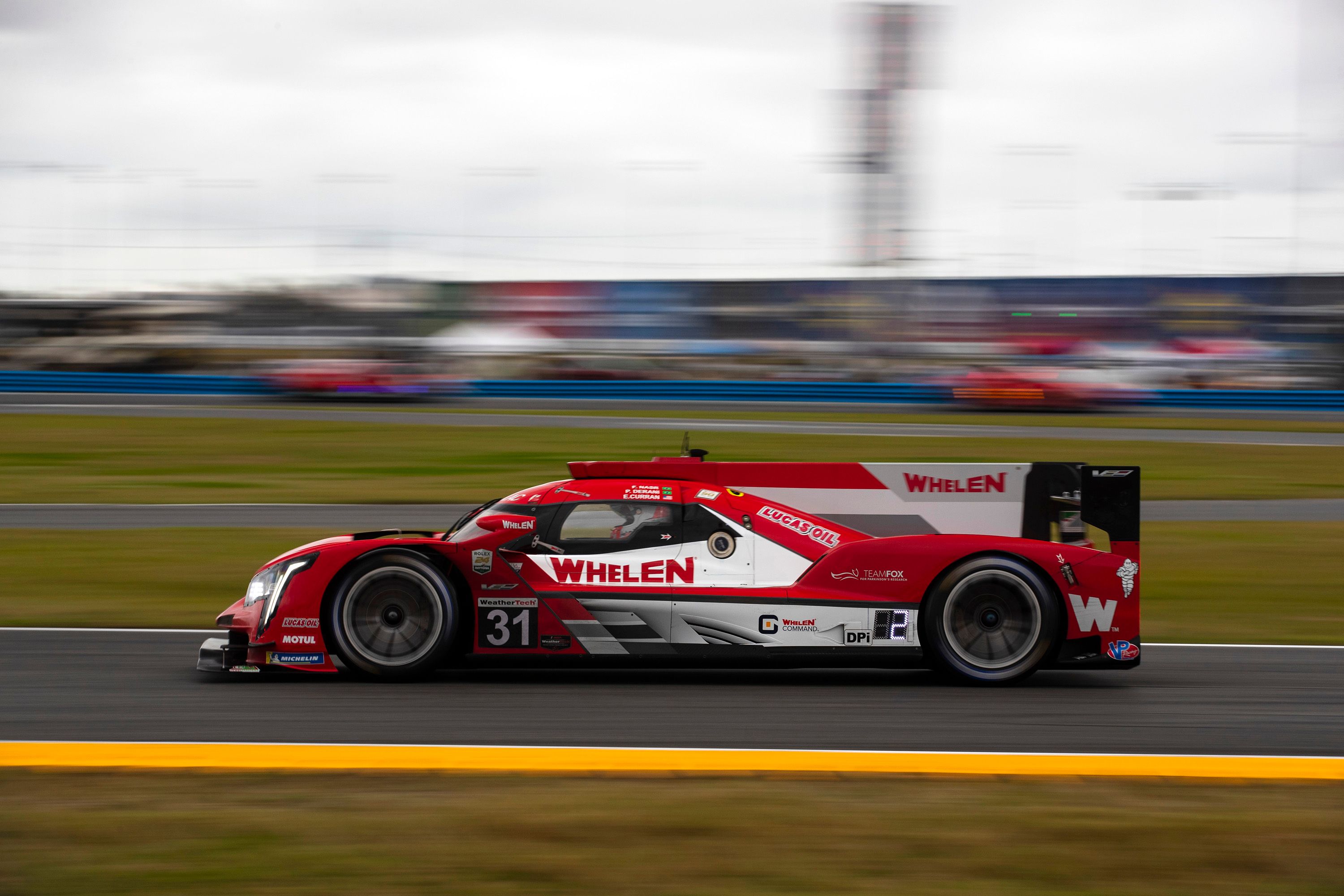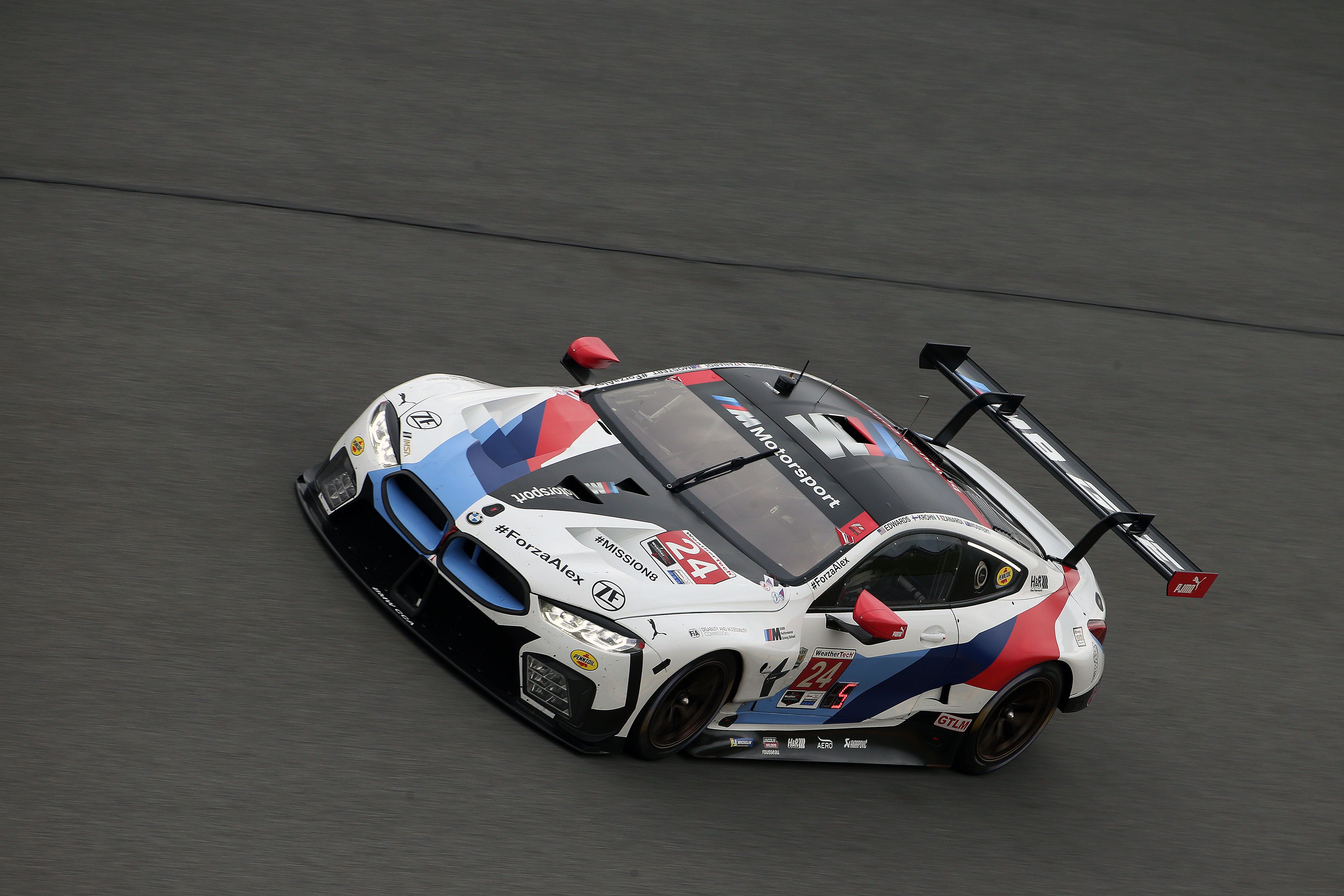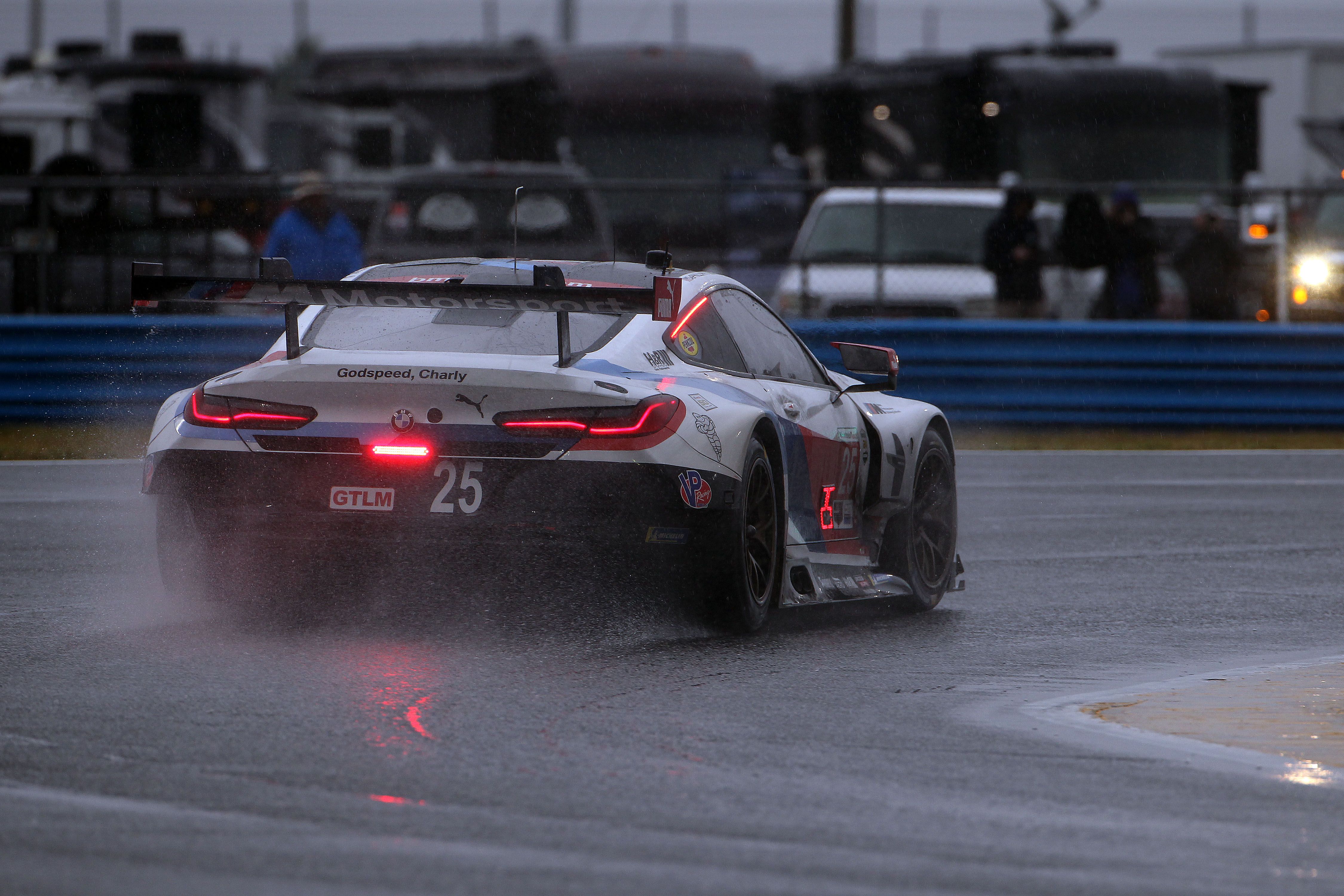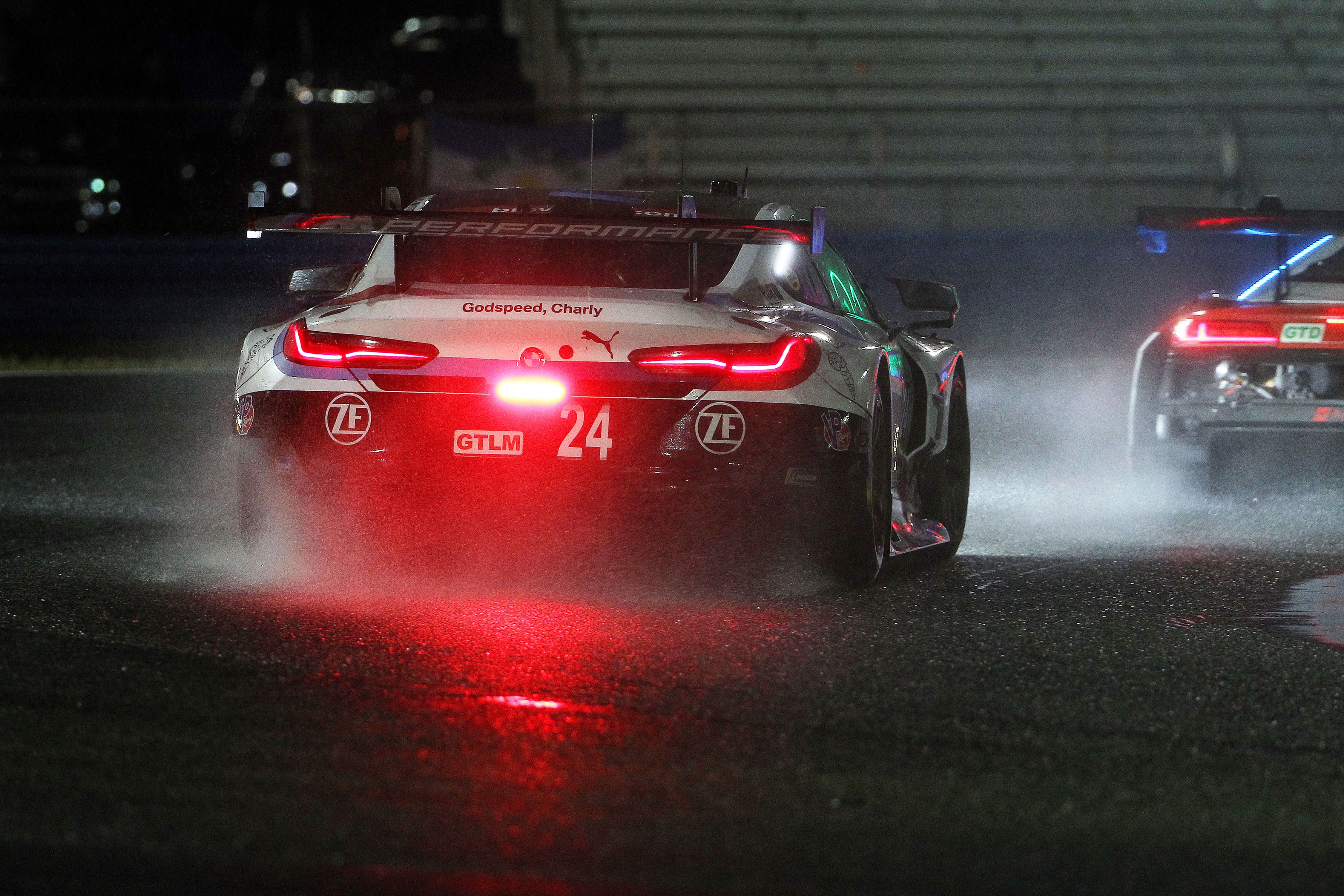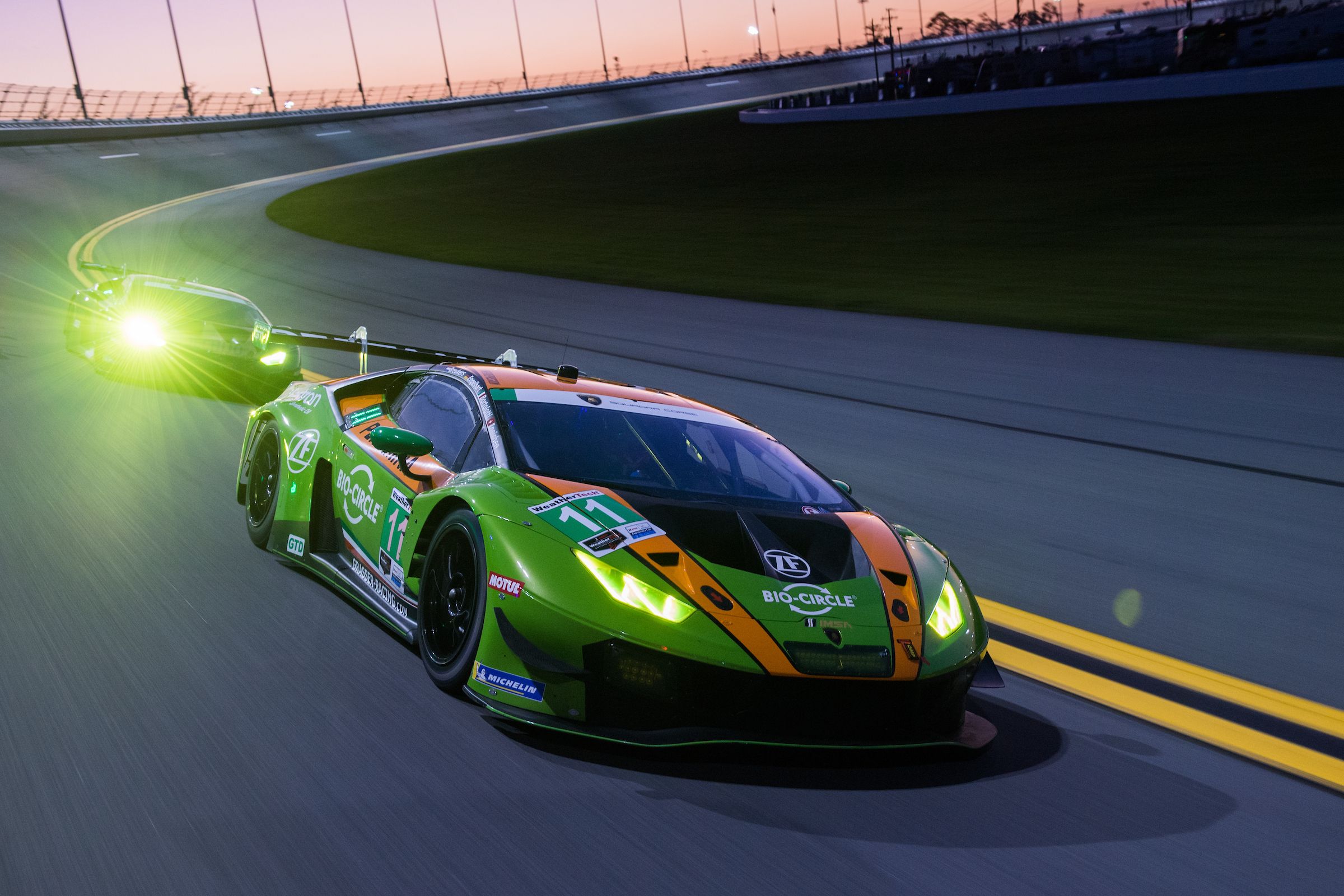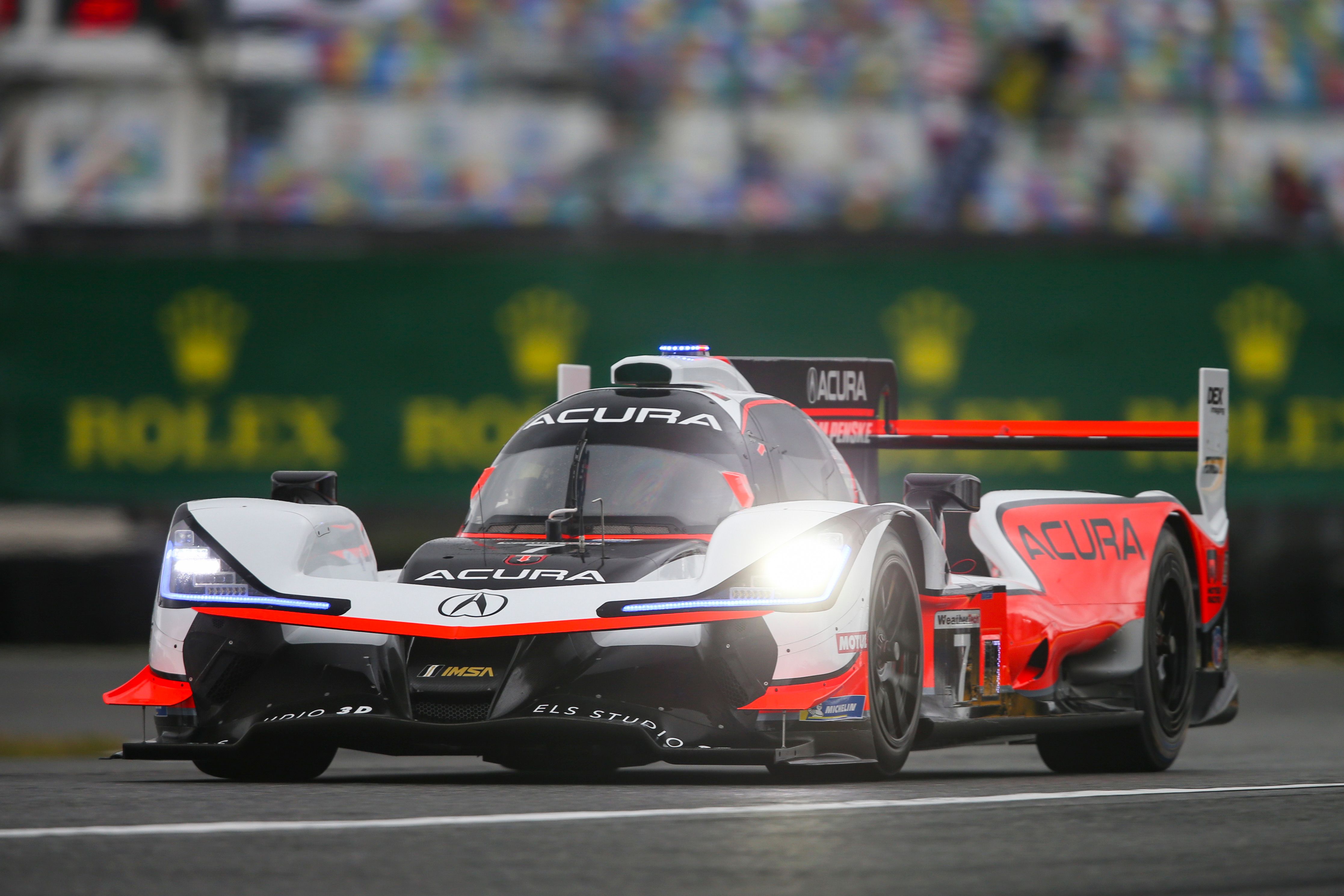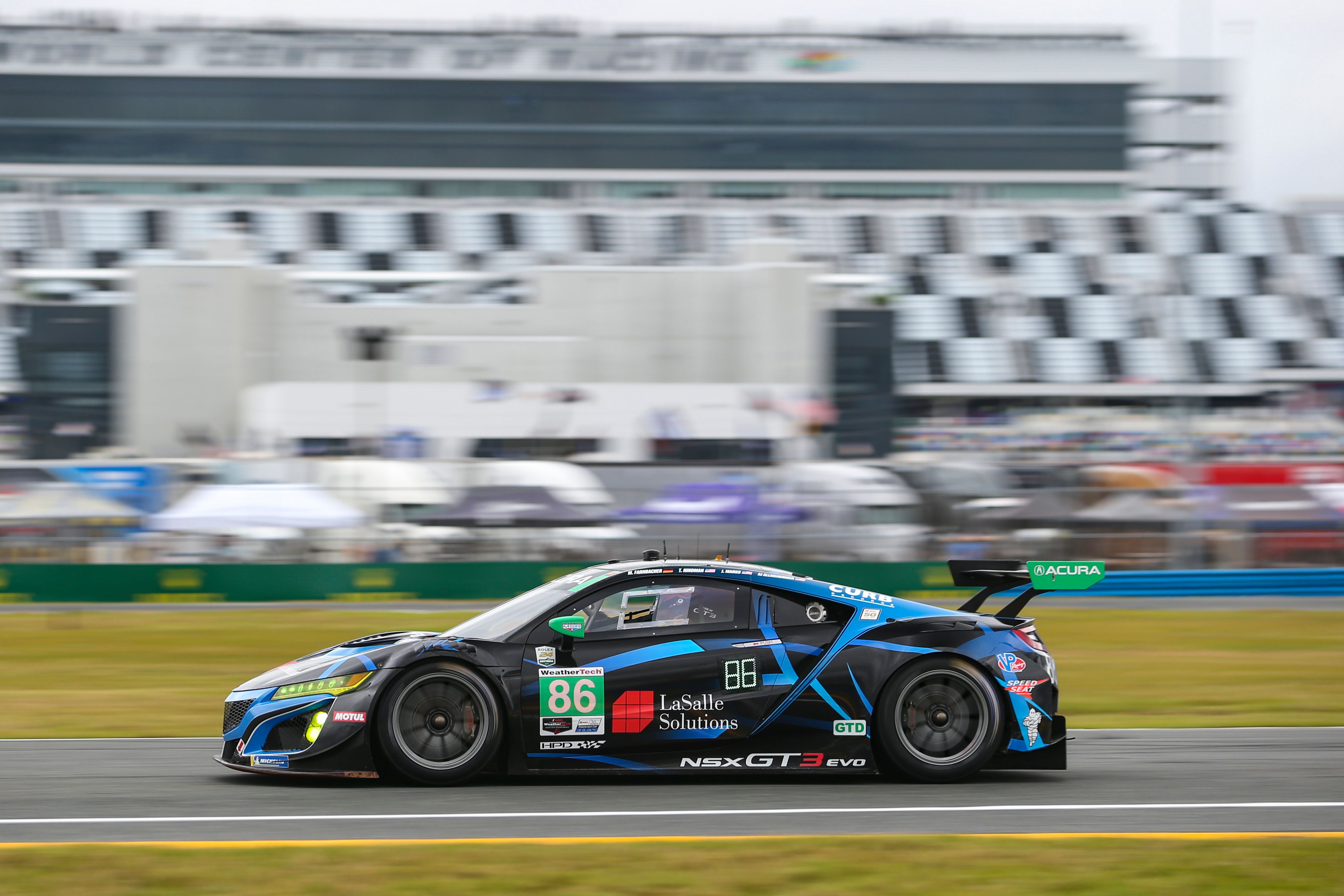The IMSA Weathertech Sportscar Championship kicked-off in grand style with a rain-soaked 57th running of the legendary Rolex 24 Hours of Daytona. Many great stories emerge from last weekend’s twice-around-the-clock enduro around the Floridian Roval, and we’re going to look at eight of the most striking.
The Daytona International Speedway, home of NASCAR’s Daytona 500, has been hosting endurance races since 1962 but, this year’s race will go down in history as one of the wettest and most riveting, with changing conditions actually ending the proceedings early, after just 23 hours and 50 minutes had elapsed. The big story, of course, was Fernando Alonso’s victory in the No. 10 Konica Minolta-sponsored Wayne Taylor Racing-entered Cadillac DPi-V.R he co-drove with Jordan Taylor, Renger van der Zande, and Kamui Kobayashi. However, the topsy-turvy event that opens IMSA’s anniversary season was action-packed in all four classes, making us already anxious for the 12 Hours of Sebring.
Besides Cadillac, we had three more class winners. BMW bagged a lucky victory with their larger-than-life M8 GTE in the GTLM category, Lamborghini won back-to-back in GTD with the Grasser Racing Team that also scored the victory 12 months ago, and Elton Julian's DragonSpeed operation won in LMP2 despite both of the cars suffering a number of accidents and the leader actually crashing out moments before the second red flag.
Alonso is now closer to both the Triple Crown of Motorsport and the Triple Crown of Endurance Racing
Spain’s Fernando Alonso has long been considered one of the best drivers on the Formula 1 grid, even when he had to contend with the lackluster McLaren cars of the last few seasons. However, few could’ve predicted Fernando’s amazing ability to turn away from F1 and jump in a sports car with almost immediate success.
Of course, his talent was never questioned, but modern F1 drivers rarely get to prove their versatility as stringent contracts have them locked within the confines of the ultra-long +20-race F1 World Championship. The teams also look back with fear at such incidents as Robert Kubica’s life-threatening crash way back in February of 2011 when the Pole gravely injured his arm while competing in the Ronde di Andora rally, merely weeks before the start of the 2011 F1 season.
As an F1 fan, you’d know that, in his 17-year tenure in Formula 1, Fernando won 32 Grand Prix races and became World Driver’s Champion twice, in 2005 and 2006, both times while racing for the Renault F1 Team. The Spaniard also won the Monaco Grand Prix on two occasions, back to back, in 2006 and 2007. To become a holder of the ‘Triple Crown of Motorsport,’ you have to win, besides the Monaco GP, the Indy 500 and the 24 Hours of Le Mans. Alonso won Le Mans last year for Toyota Gazoo Racing partnering with Kazuki Nakajima and Sebastien Buemi and will return to the Indy 500 this year after retiring from the 2017 event.
If he wins this year’s Indy 500, he’ll become only the second driver ever to add this achievement to his resume. Graham Hill, the father of 1996 F1 Driver’s World Champion Damon Hill, is the only holder of the ‘Triple Crown of Motorsport.’ The Briton won the Monaco Grand Prix five times, being known in period as ‘Mr. Monaco’. He also won the Indy 500 in 1966 and the 24 Hours of Le Mans in 1972 driving a Matra-Simca MS670 with team-mate Henri Pescarolo.
Meanwhile, endurance racing has its own triple crown and Alonso could also tick that in the future. To become a holder of this achievement, you must win the Rolex 24 Hours of Daytona, the 24 Hours of Le Mans and the 12 Hours of Sebring.
Granted, Mario Andretti, the last American F1 champ, won the race in 1972 but, that year, the event was shortened to just six hours after Ferrari argued that the engines powering the new Group 6 open-top prototypes that were derived from F1 units would simply fail over 24 hours. Ferrari won basically all races in ’72 and skipped Le Mans because ACO didn’t flinch and held their race over 24 hours regardless of Enzo’s complaints. The other F1 World Driver’s Champion to win an endurance race at Daytona was Phil Hill who won the 2000-kilometer event in 1964 with Pedro Rodriguez of Mexico.
The winning Cadillac no longer runs the production-based 6.2-liter V-8
The Cadillac DPi, built on a Dallara LMP2 chassis, debuted back in 2017 with a race-tuned version of the LT4 6.2-liter V-8 you’ll find under the hood of any Cadillac CTS.V, for example.
Nowadays, however, the Cadillac DPi’s sport a new-generation, smaller engine. It’s not a version of the LF4 turbocharged V-6 seen in the ATS.V, instead Cadillac debuted in 2018 a 5.5-liter normally-aspirated unit built by Pratt and Miller. The manufacturer switched to a smaller-displacement engine last year because of the plethora of BoP (Balance of Performance) changes thrown at the direction of the Cadillacs throughout 2017, a season in which the No. 10 Konica Minolta Wayne Taylor Racing car won the first five races on the trot. The current engine, on the other hand, boasts a more balanced torque curve and has been hit by fewer BoP changes since it was introduced.
It’s unclear right now if there will be a 5.5-liter V-8 powering a road-going Cadillac in the future, although GM does have in its portfolio the L83 5.3-liter V-8 that powers a number of trucks and pick-ups, although that’s almost a completely different engine altogether.
Two top drivers missed this year’s race due to visa-related issues
One of the works BMW drivers that was slated to drive the No. 25 BMW M8 GTE entered by BMW Team Rahal-Letterman Lanigan Racing and, also, another Toyota Gazoo Racing factory driver that appeared on the entry list aboard the No. 31 Whelen Engineering Cadillac had to miss the race due to not getting their U.S. visas in time.
As the race was never re-started, the No. 25 BMW crew unexpectedly won their class with Farfus’ final stint hailed as amazing even by Alex Zanardi. “Even if I had ten legs, I don’t think I could have done what Augusto did in the end,” was Zanardi’s reaction. The multiple-time Paralympic champion was on hand driving the No. 24 BMW M8 equipped with a special steering wheel used by Zanardi who competed for the first time ever in the Rolex 24 Hours of Daytona after being given a choice in late 2017 by BMW Motorsport boss Jens Marquardt of either doing Daytona or Le Mans.
The other driver that missed the race was Mike Conway. With no time to replace the Briton, the No. 5 Mustang Sampling-sponsored Action Express Racing-prepared Cadillac completed the race with just three drivers: Christian Fittipaldi, Joao Barbosa, and Filipe Albuquerque. It was also the last professional outing for Christian Fittipaldi who calls it quits after a three-decade-long career highlighted by a brief spell in F1 as well as three Rolex Daytona 24 Hours victories (the last achieved just last year) and two titles in the IMSA Weathertech Sportscar Championship.
This year, it was the first time that the race was red-flagged twice
The hardcore weather that hit Daytona International Speedway just after 05:00 AM EST on Sunday saw the race stopped via red flags twice. The race was never re-started after the second red flag was called and the checkered flag flew 10 minutes early as the rain kept falling unabated.
Many drivers deemed the conditions too tough to race, and they actually questioned the stewards’ decision to restart it at all after the first interruption. Eric Curran, who was part of the No. 31 Whelen Engineering driving roaster, said that it was more of a survival test than a race in those final few hours. Even Zanardi, who gave death the middle finger back in 2001, said that “even behind the safety car, at times you could lose the car.”
This is most likely the last Daytona 24 Hours for the Ford GT
The Multimatic-built Ford GT that’s been campaigned by the Chip Ganassi Racing Team since 2016 in IMSA competition might just have competed in its last Rolex 24 Hours of Daytona. The car, which won the event in both 2017 and 2018, failed to make it three in a row this year and will probably not return in works-backed capacity in 2019 as Ford looks to return to the top-flight DPi class. Chip Ganassi Racing previously operated the Riley-based Daytona Prototypes in Grand-Am and the first seasons of the new IMSA series that debuted in 2014.
The GTE-spec Ford GT has been criticized by many due to Ford’s inability to release the road car in conjunction with the race car, Chip Ganassi effectively racing the car for over a season while nobody could actually purchase its street-legal brother. With all the quarreling aside, this car already boasts an impressive resume. It first won at Laguna Seca – read that Weathertech Raceway Laguna Seca – back in 2016 and helped Ford claim the manufacturer’s title in both ’17 and ’18.
Add to that Ford’s infamous Le Mans double back in 2016 – on the 50th anniversary of their first overall victory – and you get the picture of a pretty good race car.
Now, Ford wants to move back up to DPi, but it all depends on how the new rules will shape up to be. The current ruleset expires at the end of 2021, and new rules are being drawn out for 2022. These rules should see the introduction of hybrid systems which would work for Ford as it’s seeking “innovation and tech transfer.” However, if the 2022 rules don’t bode well with the Blue Oval, there won’t be a move to the DPi class next year and, instead, the GTLM program might soldier on for at least another season as “ need to work together and bridging into each other,” according to Ford Motorsport Boss Mark Rushbrook.
BMW is also looking at a potential move to DPi although nothing is certain. That’s because both IMSA and FIA alongside ACO – the parties that decide the WEC’s future – are yet to decide on the next set of rules for each series. BMW Motorsport Boss Jens Marquardt said he’s in favor of hybridization, but in a smart way, not in a “spending” way, as he puts it. BMW units have previously powered Daytona Prototypes in the Grand-Am days and even in the early days of the current series as BMW-Dinan.
The 26-year-old qualifying lap record fell this year
The DPis were allowed to run faster than ever in 2019. That’s because, after years of trying to blend together the European-style prototypes with the American ones, the governing body finally gave up and decided to split the two entities. As such, DPis run in their own category and have thus received smaller air restrictors to give them a power hike of the European LMP2s that now play second-fiddle officially.
Once turned loose at the Roar Before the 24 test day, the manufacturer-backed prototypes showed improved pace straight out of the box. Former Bentley and Audi works driver Oliver Jarvis clocked a 1:33.398 on the 3.56 mile-long road course.
The Mazdas, powered by an AER-built 2.0-liter engine, ran at the front for much of the first six hours before hitting trouble in the seventh hour. Ultimately, both cars were retired, one after a turbocharger failed and another after getting damaged in a crash. Still, Team Joest, who took over the Mazda program from Speedsource, hopes their fortunes will finally turn around at Sebring where the team was close to victory last year.
Endurance racing fans will recognize Team Joest as the team behind many of Audi Sport’s successes in sports car racing over the last 20 years. Reinhold Joest’s outfit was onboard four eight out of Audi’s 13 overall wins while also winning numerous titles in the ALMS and the WEC. Joest Racing also won Le Mans twice on their own in 1984 and 1985, beating the works Porsche team to their second win. However, the team’s first major international victory came in 1980 when the German team won the Pepsi Challenge Daytona 24 Hours with one of its own 935Js.
The numbers of the 24 Hours of Daytona are nothing short of impressive
The longest professional race in American motorsport brings together some of the world’s finest drivers, teams, and machinery. Tens of millions of dollars line up on the starting grid each year and, each year, millions are ruined in crashes that make our eyes water. This year, the percentage of incidents was higher than in recent years due to the downpour so you could witness a Porsche crash in the back of a Ford, which in turn almost barreled into a Lamborghini or a Ferrari blinded by the fog careening in the back of a Porsche. Each of those GT cars is priced anywhere between $500,000 and $800,000, and the prototypes are even more expensive.
Of course, that’s just how much the teams paid for the cars as actually running them is what really makes racing expensive. As mentioned before, Michelin, the sole tire provider, brought thousands upon thousands of tires for each of the classes. 178 drivers from over 15 countries competed and, out of all those cars, eight were not running at the end. The overall race winner covered 593 laps, this being the first race since 2004 where the winner didn’t do at least 600 laps, a stark contrast to 2018 when the race-winning No. 5 Mustang Sampling Cadillac achieved a new distance record of 808 laps or about 2,876 miles, over 760 miles more than this year – that’s 30 miles shy off the distance between New York and Chicago.
There was one all-female crew that tackled the race
Out of all those 47 crews, one stood out in particular because all of the four drivers were women.
The result isn’t representative of the talent in that car as here you had Legge, a former DTM driver and 2018 GTD vice-champion, Nielsen, a two-time GTD champion and former IndyCar drivers Beatriz and De Silvestro who have amassed an enviable amount of racing success between the four of them. "It would have been worse if it was seen as a gimmick because the women didn’t have the results, but we’ve all proven ourselves in different categories, and I feel like this is why this lineup gets the respect it deserves,” said Nielsen prior to the race.
Legge, who previously also competed in Champ Car, IndyCar, the Indy 500, Formula E, and the NASCAR Xfinity Series, will drive full-season aboard the No. 57 Acura with Jackie Heinricher who was unable to race at Daytona due to a back injury. Meanwhile, Nielsen will most likely miss the 2019 season after the team she ran for last year, Wright Motorsport, withdrew from the series unexpectedly. She will, however, tackle the Bathurst 12 Hours this upcoming weekend. Simona De Silvestro is also familiar with the Mount Panorama circuit having competed in the Bathurst 1000 race on four different occasions with a best finish of 14th. Ana Beatriz has a history in both Indy Lights and IndyCar and currently competes in the Stock Car Brasil series.
Complete results of the Rolex Daytona 24 Hours 2019 here
Further reading
Read our full review on the 2018 Acura ARX-05 DPi.
Read our full review on the 2017 Cadillac DPi-V.R
Read our full review on the 2017 Mazda RT24-P.

